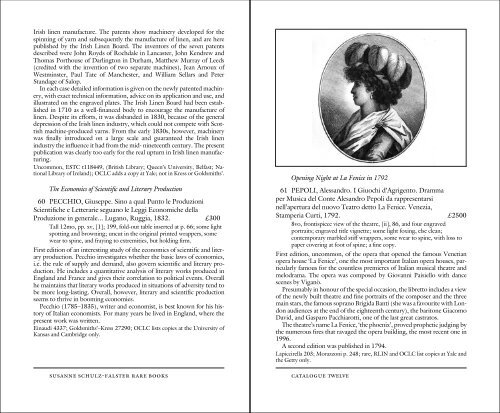Catalogue Number 12 - Susanne Schulz-Falster
Catalogue Number 12 - Susanne Schulz-Falster
Catalogue Number 12 - Susanne Schulz-Falster
Create successful ePaper yourself
Turn your PDF publications into a flip-book with our unique Google optimized e-Paper software.
Irish linen manufacture. The patents show machinery developed for the<br />
spinning of yarn and subsequently the manufacture of linen, and are here<br />
published by the Irish Linen Board. The inventors of the seven patents<br />
described were John Royds of Rochdale in Lancaster, John Kendrew and<br />
Thomas Porthouse of Darlington in Durham, Matthew Murray of Leeds<br />
(credited with the invention of two separate machines), Jean Arnoux of<br />
Westminster, Paul Tate of Manchester, and William Sellars and Peter<br />
Standage of Salop.<br />
In each case detailed information is given on the newly patented machinery,<br />
with exact technical information, advice on its application and use, and<br />
illustrated on the engraved plates. The Irish Linen Board had been established<br />
in 1710 as a well-Wnanced body to encourage the manufacture of<br />
linen. Despite its eVorts, it was disbanded in 1830, because of the general<br />
depression of the Irish linen industry, which could not compete with Scottish<br />
machine-produced yarns. From the early 1830s, however, machinery<br />
was Wnally introduced on a large scale and guaranteed the Irish linen<br />
industry the inXuence it had from the mid- nineteenth century. The present<br />
publication was clearly too early for the real upturn in Irish linen manufacturing.<br />
Uncommon, ESTC t118449, (British Library; Queen’s University, Belfast; National<br />
Library of Ireland); OCLC adds a copy at Yale; not in Kress or Goldsmiths’.<br />
The Economics of ScientiWc and Literary Production<br />
60 PECCHIO, Giuseppe. Sino a qual Punto le Produzioni<br />
ScientiWche e Letterarie seguano le Leggi Economiche della<br />
Produzione in generale... Lugano, Ruggia, 1832. £300<br />
Tall <strong>12</strong>mo, pp. xv, [1]; 199, fold-out table inserted at p. 66; some light<br />
spotting and browning; uncut in the original printed wrappers, some<br />
wear to spine, and fraying to extremities, but holding Wrm.<br />
First edition of an interesting study of the economics of scientiWc and literary<br />
production. Pecchio investigates whether the basic laws of economics,<br />
i.e. the rule of supply and demand, also govern scientiWc and literary production.<br />
He includes a quantitative analysis of literary works produced in<br />
England and France and gives their correlation to political events. Overall<br />
he maintains that literary works produced in situations of adversity tend to<br />
be more long-lasting. Overall, however, literary and scientiWc production<br />
seems to thrive in booming economies.<br />
Pecchio (1785–1835), writer and economist, is best known for his history<br />
of Italian economists. For many years he lived in England, where the<br />
present work was written.<br />
Einaudi 4337; Goldsmiths’–Kress 27290; OCLC lists copies at the University of<br />
Kansas and Cambridge only.<br />
Opening Night at La Fenice in 1792<br />
susanne schulz-falster rare books catalogue twelve<br />
61 PEPOLI, Alessandro. I Giuochi d’Agrigento. Dramma<br />
per Musica del Conte Alesandro Pepoli da rappresentarsi<br />
nell’apertura del nuovo Teatro detto La Fenice. Venezia,<br />
Stamperia Curti, 1792. £2500<br />
8vo, frontispiece view of the theatre, [ii], 86, and four engraved<br />
portraits; engraved title vignette; some light foxing, else clean;<br />
contemporary marbled stiV wrappers, some wear to spine, with loss to<br />
paper covering at foot of spine; a Wne copy.<br />
First edition, uncommon, of the opera that opened the famous Venetian<br />
opera house ‘La Fenice’, one the most important Italian opera houses, particularly<br />
famous for the countless premieres of Italian musical theatre and<br />
melodrama. The opera was composed by Giovanni Paisiello with dance<br />
scenes by Viganò.<br />
Presumably in honour of the special occasion, the libretto includes a view<br />
of the newly built theatre and Wne portraits of the composer and the three<br />
main stars, the famous soprano Brigida Banti (she was a favourite with London<br />
audiences at the end of the eighteenth century), the baritone Giacomo<br />
David, and Gasparo Pacchiarotti, one of the last great castratos.<br />
The theatre’s name La Fenice, ‘the phoenix’, proved prophetic judging by<br />
the numerous Wres that ravaged the opera building, the most recent one in<br />
1996.<br />
A second edition was published in 1794.<br />
Lapiccirella 203; Morazzoni p. 248; rare, RLIN and OCLC list copies at Yale and<br />
the Getty only.

















